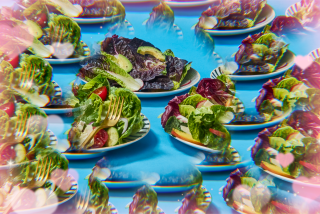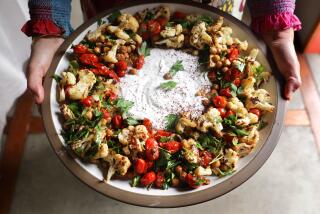Green Stuff
- Share via
Green salads today are a far cry from the quintessential wedge of iceburg lettuce, drizzled with bright orange, so-called French dressing, that graced tables in many parts of this country during the 1950’s. Most markets now stock more than a dozen varieties of leafy greens for use in salads, ranging in flavor from bland to pleasantly bitter.
Textures vary from crisp to buttery. Some greens stand well on their own; others are best used in combination or as accents. With the exceptions of sorrel and spinach, which may also be cooked, these greens are typically utilized raw.
Arugula (rugula, rocket and roquette)--Deep green, slender leaves with a spicy, mustard flavor. Best used as an accent in mixed salads. May sometimes have edible yellow flowers attached.
Belgian Endive (Witloof chicory)--Because they are protected from the light during growth, the small, smooth, slender heads are creamy white tinged with light yellow at the tips. Mildest in flavor of the chicory family, but still pleasantly bitter.
Butter lettuce--Bibb, Boston, buttercrunch and limestone are similiar varieties. Medium size heads with loosely furled leaves that are medium green on the outside, paler green to yellow in the center. Sweet, subtle, buttery flavor; soft, delicate texture.
Cilantro (Chinese parsley, coriander)--Member of the parsley family with finely fringed, flat, bright green leaves. Pungent flavor of this herb is best used as an accent for mixed greens.
Curly Endive (chicory)--Sprawling heads of crimped green leaves, the outer, dark green more bitter than the paler ones within. Prickly texture. Used mainly in combination with other greens.
Escarole (broad-leafed endive)--A cousin of curley endive, but the leaves are less crimped and paler in color. Less bitter than its relative, but still sharp-tasting. Best used as an accent to other greens.
Iceberg lettuce (crisphead)--Still the most widely sold lettuce in the United States. Heads have circular, tightly furled medium green outer leaves, paler inner leaves. Crisp texture; very mild flavor.
Mache (lamb’s lettuce, corn salad)--Small, dark, spoon-shaped leaves loosely clustered into rosettes. Faintly sweet flavor.
Radicchio (red chicory, Italian red lettuce)--Baseball size heads of burgundy leaves with cream-colored veins are most commonly found in this country, but there are a variety of sizes, shapes and colors. Excellent for adding color to salad mixtures, but may also be served solo. Bitter flavor, similiar to escarole.
Red leaf lettuce--Oak leaf is a similar variety of this ruffly, loose-leaf lettuce. Soft texture, sweet flavor. Provides a good color accent for salads.
Romaine (Cos)--Loosely packed, oblong leaves that are medium to dark green at the edges, greenish-white near the center vein. Crunchy texture, mildly pungent flavor.
Salad Bowl--Variety of loose-leaf lettuce. Curly pale-green leaves that are tender and delicately flavored.
Sorrel (dock)--Smooth, bright to dark green, tongue-shaped leaves that have a faint lemony flavor. Best used as a flavor accent for other greens.
Spinach--Variety most commonly found in markets has smooth, dark green leaves, however there are also crinkled-leaf types. Flavor is mild, faintly musky, the texture coarse.
Watercress--Round, dark green leaves with a sharp, spicy flavor. Best used as an accent for other greens.
When buying salad greens, select those that appear fresh and are free of blemishes such as yellowed leaves or rust spots. Head varieties should feel firm, but not hard.
It’s best to use greens as soon as possible after purchase, but they may be stored for a few days. Opinions differ on whether greens last longer if they are washed before being refrigerated or just prior to use. It is agreed, however, that they need a thorough washing to remove grit, but should not be allowed to soak.
Head lettuce-- Remove stem end either with fingers or knife. Hold head under cold, running water, allowing to spread leaves apart and cleanse. Drain well. Use immediately or wrap in paper towels, place in plastic food bag and refrigerate.
Loose-leaf lettuce-- Twist off stem end or cut with knife. Separate leaves and rinse under cold running water or swish in sink filled with cold water, then lift out, letting soil sink to bottom. Repeat until no grit remains. Drain well. Use immediately or wrap in paper towels, place in plastic food bag and refrigerate.
Cilantro and watercress-- open bunch and rinse under cold, running water. Drain well. Use immediately or stand bunch in glass of cold water, cover with plastic food bag and refrigerate.
For dressing to coat salad greens, the greens must be dry. After washing, place on paper towels or clean kitchen towel and blot with another towel. Salad spinners, which remove water by centrifugal force, are another option. Plastic models are preferred over wire mesh baskets which can bruise greens and spray water when they are spun.
For years it was believed that greens were also bruised if cut with a knife. This theory is now being challenged, but most people still believe that greens are more appealing when torn into bite-size pieces, removing any tough stems or ribs. One to two cups of lightly packed greens are considered a serving.
Cleaned greens may be torn in advance and placed in a plastic food bag or covered in the bowl in which they will be mixed, then refrigerated several hours before serving. To prevent greens from wilting, toss with dressing and other desired ingredients just before serving.
More to Read
Eat your way across L.A.
Get our weekly Tasting Notes newsletter for reviews, news and more.
You may occasionally receive promotional content from the Los Angeles Times.










